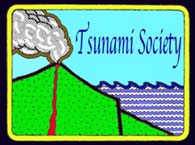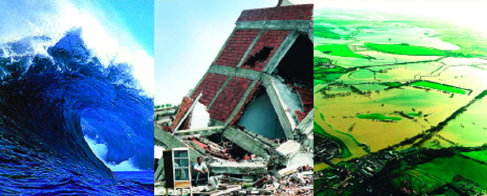ISSUES - Year 2011
ISSN 8755-6839
VOLUME
30, No. 2 (2011) 
ABSTRACTS
for Volume 30, No 2
Complete Journal - STHVol30N2Y2011 (PDF Document 13.2 MB)
Journal in compressed format - STHVol30N2Y2011 (PDF Document 1.5 MB)
------------------------
THE 1990 BOHOL EARTHQUAKE: TSUNAMI OBSERVATIONS AND EFFECTS AT BOHOL ISLAND, PHILIPPINES (3.9 MB) Compressed (292 KB).
G.M. Besana-Ostman - Research Center for Seismology, Volcanology and Disaster Mitigation
School Environmental Studies, Nagoya University, Nagoya, JAPAN;
Philippine Institute of Volcanology and Seismology (PHIVOLCS), Dept. of Science and Technology, Quezon City, PHILIPPINES;
National Institute of Geological Sciences, University of the Philippines, Quezon City, PHILIPPINES
; Now at: *Instituto Superior Técnico, Lisboa, PORTUGAL
M. Ando - Research Center for Seismology, Volcanology and Disaster Mitigation
School Environmental Studies, Nagoya University, Nagoya, JAPAN;
Now at +Institute of Earth Sciences, Academia Sinica, Nankang, Taipei, TAIWAN
J.A. Daligdig - Philippine Institute of Volcanology and Seismology (PHIVOLCS), Dept. of Science and Technology, Quezon City, PHILIPPINES
M.I.T. Abigania - Philippine Institute of Volcanology and Seismology (PHIVOLCS), Dept. of Science and Technology, Quezon City, PHILIPPINES; National Institute of Geological Sciences, University of the Philippines, Quezon City, PHILIPPINES
J.E. Talisic
- Philippine Institute of Volcanology and Seismology (PHIVOLCS), Dept. of Science and Technology, Quezon City, PHILIPPINES
N. Evangelista - Philippine Institute of Volcanology and Seismology (PHIVOLCS), Dept. of Science and Technology, Quezon City, PHILIPPINES
E. Listanco - National Institute of Geological Sciences, University of the Philippines, Quezon City, PHILIPPINES
R.U. Solidum
- Philippine Institute of Volcanology and Seismology (PHIVOLCS), Dept. of Science and Technology, Quezon City, PHILIPPINES
ABSTRACT
The earthquake of February 8, 1990 offshore the Island of Bohol in the Central Philippines was a tsunamigenic event caused by crustal displacements along an unknown northeast-southwest trending fault. Isoseismal distribution confirmed such orientation with higher seismic intensities at the southeastern areas of Bohol Island. Subsequent field surveys, interviews with eyewitnesses and measurements of runup heights, support that significant tsunami inundation occurred along the southeastern coast of the island. Based on this investigation and review of historical data, we conclude that the source region of the 1990 tsunami was along an unknown offshore submarine structure.
Keywords: seismic intensity, Alicia Thrust Fault, East Bohol fault, tsunami, runup, tsunami height, Bohol, Philippines, tsunami hazards
Science of Tsunami Hazards, Vol. 30, No. 2, page 78 (2011)
------------------------
TSUNAMI- SEDIMENT SIGNATURES IN MANAKUDY ESTUARY ALONG THE WEST COAST OF INDIA (2,6 MB) Compressed (328 KB)
Rashi M. - Geochemical Lab, Dept of Chemistry and Research Centre, Scott Christian College, Nagercoil, INDIA
Vetha Roy D. - Geochemical Lab, Dept of Chemistry and Research Centre, Scott Christian College, Nagercoil, INDIA
Chandrasekhar N. - Centre for Geotechnology, Manonmaniam Sundaranar University, Abishekhapatti, Tirunelveli, INDIA
ABSTRACT
The December 26, 2004 tsunami left its imprints along the southern coast of India especially the coastal areas of Manakudy in Kanyakumari district of Tamil Nadu. In the study area - Manakudy estuary - the post-tsunami sediment texture is predominantly coarser as inferred from textural analysis. Granulometric analysis indicates a shift of well-sorted, coarse skewed and platykurtic nature during the pre-tsunami season, to moderately sorted, fine skewed and leptokurtic behavior, after the tsunami. Violent hydrodynamic conditions have prevailed during the post-tsunami deposition of sediments. The unimodal nature of the post-tsunami sediments as distinct from the bimodal pre-tsunami sediments is reflected from the frequency curves. The CM diagram and the log probability curves confirm these observations.
Keywords: tsunami, Manakudy Estuary, Tamilnadu, sediment deposition, granulometric analysis
Science of Tsunami Hazards, Vol. 30, No. 2, page 94 (2011)
------------------------
THE ROLE OF MEDIA IN IN SCIENCE AND TECHNOLOGY EDUCATION, DEVELOPMENT AND REHABILITATION OF WOMEN AFFECTED BY THE 2004 TSUNAMI IN THE OF THE STATE OF TAMILNADU
P. Sri Jothi - Dept of Media Sciences, College of Engineering, Anna University, Chennai, INDIA
M. Neelamalar - Dept of Media Sciences, College of Engineering, Anna University, Chennai, INDIA
ABSTRACT
The great Sumatra earthquake of 26 December 2004 generated a destructive tsunami which devastated coastal communities bordering the Indian Ocean, killing thousands of people in Indonesia, Sri Lanka, India, Thailand, Somalia, Myanmar, the Maldives, Malaysia, Tanzania, Seychelles, Bangladesh, South Africa, Yemen and Kenya. It was one of the deadliest natural disasters in modern history. In India, the death toll and damages were severe, particularly along the southern and eastern coastal regions. Subsequently, central and state government authorities in the state of Tamilnadu - one of the most severely stricken regions - took immediate measures for tsunami preparedness and rehabilitation. The media played a major role in this effort by communicating to the public information related to the science and technology facts of tsunami hazards and to ways of mitigating their impact with better understanding and preparedness. Through its superior ability to communicate effectively information, the media became the role model in helping people make decisions for their own welfare. The present study was undertaken for the purpose of determining the media’s role in the post-rehabilitation efforts and particularly in improving the status of affected women of the north Chennai region, who were forced to migrate from Ernavour and Ennore, in Chennai district, in the India state of Tamilnadu, by providing them science and technology communication.
Keywords: India; tsunami; media; preparedness; rehabilitation; post-disaster; education.
Science of Tsunami Hazards, Vol. 30, No. 2, page 108 (2011)
------------------------
TSUNAMIGENIC SOURCE MECHANISM AND EFFICIENCY OF THE MARCH 11, 2011 SANRIKU EARTHQUAKE IN JAPAN (6.4 MB) Compressed (476 KB)
George Pararas-Carayannis - Tsunami Society International, Honolulu, Hawaii, USA
ABSTRACT
The great Tohoku earthquake of March 11, 2011 generated a very destructive and anomalously high tsunami. To understand its source mechanism, an examination was undertaken of the seismotectonics of the region and of the earthquake’ focal mechanism, energy release, rupture patterns and spatial and temporal sequencing and clustering of major aftershocks. It was determined that the great tsunami resulted from a combination of crustal deformations of the ocean floor due to up-thrust tectonic motions, augmented by additional uplift due to the quake’s slow and long rupturing process, as well as to large coseismic lateral movements which compressed and deformed the compacted sediments along the accretionary prism of the overriding plane. The deformation occurred randomly and non-uniformly along parallel normal faults and along oblique, en-echelon faults to the earthquake’s overall rupture direction – the latter failing in a sequential bookshelf manner with variable slip angles. As the 1992 Nicaragua and the 2004 Sumatra earthquakes demonstrated, such bookshelf failures of sedimentary layers could contribute to anomalously high tsunamis. As with the 1896 tsunami, additional ocean floor deformation and uplift of the sediments was responsible for the higher waves generated by the 2011 earthquake. The efficiency of tsunami generation was greater along the shallow eastern segment of the fault off the Miyagi Prefecture where most of the energy release of the earthquake and the deformations occurred, while the segment off the Ibaraki Prefecture – where the rupture process was rapid – released less seismic energy, resulted in less compaction and deformation of sedimentary layers and thus to a tsunami of lesser offshore height. The greater tsunamigenic efficiency of the 2011 earthquake and high degree of the tsunami’s destructiveness
along Honshu’s coastlines resulted from vertical crustal displacements of more than 10 meters due to up-thrust faulting and from lateral compression and folding of sedimentary layers in an east-southeast direction which contributed additional uplift estimated about 7 meters - mainly along the leading segment of the accretionary prism of the overriding tectonic plate.
Keywords - Japan; Honshu; Sanriku; earthquake; seismotectonics; tsunami; source-mechanism; tsunamigenic efficiency; Japan Trench.
Science of Tsunami Hazards, Vol. 30, No. 2, page 126 (2011)
--------------------------------------------
Copyright © 2011 - TSUNAMI SOCIETY INTERNATIONAL
TSUNAMI SOCIETY INTERNATIONAL, 1741 Ala Moana Blvd. #70, Honolulu, HI 96815, USA.
WWW.TSUNAMISOCIETY.ORG




